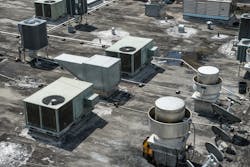For our March issue, I turn the First Word page over to guest columnists Bud Hammer, president, and Tom Burbank, vice president of service and tech operations at Atlantic Westchester. Here, they explain Atlantic Westchester's approach to building retrofits. Visit their website at www.atlanticwestchester.com, to see their message to building owners seeking advice and strategies for building re-entry following the COVID-19 pandemic. -- Terry McIver
---------------
There are many types of building retrofits and they can be performed for a multitude of reasons. Some of the reasons Atlantic Westchester gets involved with a retrofit typically falls into one of the following categories:
1) Building modifications or building use changes
A very common situation is that building owners or managers don’t want to utilize a space the same way as when it was built. A routine example is when a school district decides to repurpose a custodial closet for a new server room. First off, we’d speak with the client to discuss their end goals and evaluate how much heatingThe hot topics right now are what type of filtration can be put inside buildings or how to clean the air.
2) Obsolete HVAC equipment or controls
One of our clients, a childcare center, reached out to us asking for help because they were subject to technology obsolescence. They had an obsolete building management system with no visibility to change setpoints, view space conditions or modify a schedule. Our first step was to identify the client’s needs in priority3) Energy conservation measures
Clients are often trying to tighten their operating budget by investing in their existing HVAC technology, so it’s important to discuss how they operate their current system. We first gather data on the HVAC technology and controls in the building to paint a picture of how the building is currently operating. We then break down energy conservation costs into low, medium, and high cost retrofits. We had a client who had two oversized chillers that were failing. So, we evaluated the building load profile and were able to replace with smaller capacity units, thereby providing a better match for the connected load and obtain a utility incentive for permanent reduction in energy. Overall, once all options are evaluated, we discuss with the client our findings and partner with them to implement a practical energy efficient solution.
4) Indoor air quality concerns
The most recent concerns have been indoor air quality. The hot topics right now are what type of filtration can be put inside buildings or how to clean the air. We evaluate the existing equipment by seeing if the fan is designed to handle extra pressure drops by changing filters to a higher MERV rating (Minimum Efficient Reporting Value). It’s important to spend time determining whether or not the equipment can handle extra air resistance, because without the proper evaluation the equipment could operate outside of its intended condition and therefore have performance issues.
When it comes to retrofits there is not one size fits all, rather, there are many different levels of HVAC technology to support changes in building occupancy, reduce energy consumption, upgrade from obsolete equipment, or provide building occupants clean air for them to breath in.
Bud Hammer is President of Atlantic Westchester, Bedford Hills, NY. Tom Burbank is Atlantic Westchester's vice president of service and tech operations.
About the Author
Bud Hammer
President
Bud Hammer is President, Atlantic Westchester, Inc., a commercial and industrial HVAC and energy efficiency company located in Bedford Hills, NY. Atlantic Westchester offers a variety of commercial and industrial HVAC solutions for businesses, institutions and government facilities across the NY metro area. For additional information, visit atlanticwestchester.com.


